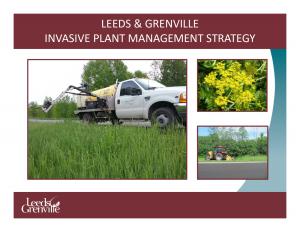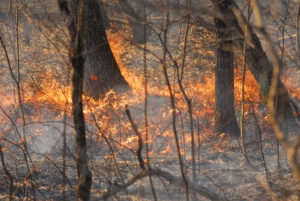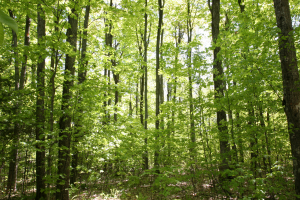Jim Hendry
News Release - European Gypsy Moth Fact Sheet
Leeds & Grenville - Invasive Plant Management Strategy
Collaborating to Manage Forest-Health Threats
Observing and learning about the forests to the south of eastern Ontario provides managers a view into the not to distance future. This presentation highlights both current and emerging forest pests in St. Lawrence County, in the state of New York. Management techniques addressing preventation, detection, and control provides tangible tools for eastern Ontario forest managers to use in the fight against invasive forest pests.
Regional Forest Health Network
This presentation provides an overview of the Regional Forest health Network, it's origins, membership, accomplishments and what the Network will be working on in the near future.
Forestry Documentary influences Grade 12 Student to Choose Forestry as Career Path
I was also fascinated by the variety of career paths forestry can take you. For many of my friends at school who are pursuing studies in business, engineering, and the arts, when they hear the word forestry, or forester, they think of lumberjacks and clear cutting, but in reality, this is not the whole picture. There is a significant amount of biology, economics, politics and cultural aspects involved in the research and processes behind forestry practices. It is a convergence of all these things. This is what drew me to forestry - just how diverse it is with respect to its connections with society. It’s also a profession where I can work, as well as conserve and manage the place that I love
The EOMF had the opportunity to meet with Aidan Holland who is graduating from grade 12 in Ottawa this year and will be studying Forestry at the University of Alberta this September. Curious about how he came to choose forestry as a career, we learned that a key influence was the film that the EOMF developed last year with Pinegrove Productions “Trees, Youth, our Future”! Aidan allowed us to interview him to learn more about how he came to his final decision.
Astrid: Hi Aidan, congratulations on your upcoming graduation and acceptance into the forestry program at the University of Alberta. I might be a little biased, but you’ve chosen a great career path! Can you tell me a little bit more about how you became interested in learning more about managing our forest resource?
Aidan: When I entered high school, I knew that I wanted to work toward pursuing a career in a science-related field. Throughout high school I was involved in a variety of activities that allowed me to be out in nature. Whether it was at my summer camp in Haliburton where I went on week-long canoe trips through Northern Ontario, or with my scouts group, where I had the chance to hike along the northern coast of Lake Superior. When I returned to school in the fall each year, all I could think about, or talk about, were my trips from over the summer. I wanted to go back to the forests and lakes of Eastern and Northern Ontario where I felt most at home.
Astrid: It sounds like you had some great experiences in high school. You mentioned that you had the opportunity to watch the film “Tree, Youth, our Future”. Can you tell us how that happened and how it influenced your decision?
Aidan: Last summer, my brother, who had just finished a degree in Environmental Sciences, was working at the Petawawa Research Forest, along the border of Algonquin Park. Over the summer I visited him as he worked at the forest. I began to grow a great appreciation for the forest and the surrounding area with the magnificent white and red pine stands. Later that year, when my brother was working in Ottawa, he was able to show my family and I a “special” pre-screening of a two-part documentary series called “Trees, Youth, our Future” It was about the history of the forest industry in the Ottawa valley, the evolution of forestry practices, and the future of Ontario’s forests. The message of the documentary seemed to speak to me, especially after spending so much time over the years exploring Ontario’s forests.
Astrid: That’s great to hear Aidan as the intent of this film was to promote it to young people like you with the hopes of encouraging more to choose forestry as a career. Was there anyone that you met along the way that helped you with your decision?
Aidan: During this time, my community was organizing an urban forestry initiative called the Neighbourwoods tree inventory. That spring and summer I was able to learn more about the forestry and the opportunities it presented, hands-on. That is where I met Dr. Andy Kenney (Professor Emeritus, University of Toronto and EOMF member), one of the founders of the program and an experienced forester. Learning from him and gaining insight into what a career in forestry might be like was an incredible experience.
Astrid: Once you were sold on forestry, how did you go about finding the program at the University of Alberta?
Aidan: I began to look more into different forestry programs and discovered the hands-on approach to learning the degree offered - with field schools and other related excursions. I was also fascinated by the variety of career paths forestry can take you. For many of my friends at school who are pursuing studies in business, engineering, and the arts, when they hear the word forestry, or forester, they think of lumberjacks and clear cutting, but in reality, this is not the whole picture. There is a significant amount of biology, economics, politics and cultural aspects involved in the research and processes behind forestry practices. It is a convergence of all these things. This is what drew me to forestry - just how diverse it is with respect to its connections with society. It’s also a profession where I can work, as well as conserve and manage the place that I love. During my last year in high school I continued to look into my options for Forestry and eventually accepted my offer at the University of Alberta. I really liked the program and courses they offered, and of course they have two awesome field schools throughout the degree.
Astrid: Thank you Aidan for your story and great insights. All the best with your studies and your career. Be sure to check back with us regularly!
To view the documentary “Trees, Youth, our Future, please visit the EOMF website at https://www.eomf.on.ca/documentary. If you are interested in hosting an event to show the film, please contact Astrid at This email address is being protected from spambots. You need JavaScript enabled to view it. or 613-258-6587.
Astrid Nielsen, General Manager, Eastern Ontario Model Forest
Spring 2019 Updates - New York Invasive Species Research institute
Updates on new New York Invasive Species Research Insitiute publications and upcoming events. Read about the Spring Updates.
EOMF - Certified Forest owners creating and enhancing wildlife habitat across Ontario
The Eastern Ontario Model Forest (EOMF) is a not-for-profit, charitable organization that works to promote sustainable forest management practices througout Ontario.
Our core programs of Forest Certification, Forest Education and Outreach, Regional Forest Health Network and Community Forest Carbon Offsets are guided by a desire to balance the economic, social and environmental pillars of sustainability.
 Loggers in Renfrew County Forest helping to create wildlife habitat by topping dead red pine tress, when safe to do so!
Loggers in Renfrew County Forest helping to create wildlife habitat by topping dead red pine tress, when safe to do so!
Photo credit: Lacey RoseIn 1999 the EOMF began to explore forest certification as a means of promoting sustainable forest management for private forest owners. In 2003 the EOMF received Forest Stewardship Council® (FSC®) Group Forest Management certification (FSC® Co18800). Our “Forest Certification Program” now covers over 82,000 hectares of certified forest, represented by 13 community forests, 110 private forest owners, 2 commercial forests, 3 independent forest managers and 5 maple syrup producers. Each forest owner manages their forests based on FSC®’s 10 Principles of sustainable management and detailed in the Great Lakes/St. Lawrence Region Standards.
Key to the principles of sustainable management is managing for biodiversity and creating or enhancing wildlife habitat, while ensuring other environmental, social, and economic benefits are achieved. During many of our field visits and annual FSC® audits, we have witnessed first hand the commitment and dedication that forest managers have towards the importance of forest biodiversity and wildlife creation and enhancement initiatives.
The range of biodiversity and wildlife enhancement projects taking place on certified forests is both impressive in number and scope. Private forest owners, community forest managers, and loggers alike are leading and implementing these types of projects at both the stand and landscape levels. A short list of these projects includes invasive species control, development of Biodiversity Strategies, rare species recovery, species at risk habitat enhancement and protection, riparian habitat restoration, wetland protection, medicinal and culturally significant plant surveys, intensive wildlife management areas, to name a few.
The following two examples demonstrate the range and scale of involvement of certified forest managers in promoting healthy diverse forest ecosystems.
Bruce County Forests - Enriching biodiversity in white cedar dominated forests
Bruce County owns approximately 4,700 hectares of forest, located over eight tracts. The largest of these properties is the Lindsay Tract, which is 2,800 ha of primarily cedar dominant stands located in the Municipality of Northern Bruce Peninsula. Cedar is one of the most sought after species by local timber producers, but managing this particular resource poses many challenges, including excessive blow-down, slash management, herbaceous competition, and the establishment of desireable regeneration.
 Forty small patch clear-cuts, Lindsay Tract.
Forty small patch clear-cuts, Lindsay Tract.
Photo credit: Kevin PredonA recent cedar harvest operation in 2016 demonstrated a unique harvest method to address these challenges, while promoting species and habitat diversity. Kevin Predon, Forest Manager for Bruce County implemented a harvest system of small circular patch clearcuts with connecting corridors. This system had been suggested by Fred Pinto, RPF.
The harvest area was delineated into 40 individual circular clear-cuts, approximately 30-50 metres in diameter, with connecting corridors. This method allowed the lower density areas to be left undisturbed while targeting those that were more operationally feasible. The cut areas helped to create greater habitat diversity while the uncut areas provided a good supply of desirable seeds, including white pine.
There is also a significant population of Massassauga Ratttlesnakes, a species at risk, living in the Lindsay Tract. To mitigate the risk of harming any snakes, operational timing restrictions were used as outlined in MNRF’s Forest Management Guide for Conserving Biodiversity at the Stand and Site Scales. As a result, harvest was restricted to the winter months.
 Massassauga rattlesnake Lindsay Tract cutover.
Massassauga rattlesnake Lindsay Tract cutover.
Photo credit: Kevin PredonEarly observations have been positive. The slash left on site as helped to protect the shallow soils, while machine travel has broken and lowered the slash, thus hastening decomposition. Regeneration in the form of white pine has already begun to germinate in the exposed soil areas and few trees have fallen over in the uncut areas as a result of the smaller openings. Furthermore, while conducting a summer site visit in 2018 a few Massassaugas were encounter, an encouraging sign!
Northumberland Count Forest – Advancing Oak Savannah Habitat
The Northumberland County Forest is 2,225 ha of mainly forested land on the Oak Ridges Moraine. The forest is a mix of planted and natural forest and wetlands. One of the most unique communities present is the globally rare ecosystem - Black Oak savannah and woodland. Less than one percent of this habitat is left in North American due to habitat modification, habitat loss, succession and fire suppression. Oak regeneration is being replaced with maple and cherry, and the unique species that depend on the ecosystem are also disappearing.
 Oak Savannah habitat prescribed burn, Northumberland County Forest
Oak Savannah habitat prescribed burn, Northumberland County Forest
Photo credit: Todd Farrell“Typically, the management of this ecosystem involves prescribed burns”, says Todd Farrell, Forest Manager. This increases light levels, helps to remove non-native and non-woodland plants and helps stimulate oak regeneration. Research in the United States has shown that a combination of thinning of canopy trees and prescribed burns provides the desirable environment for this ecosystem to thrive. Northumberland County Forest has documented these areas as high conservation values and are using thinning and prescribed burns to ensure these globally rare habitats and the species that live in them prosper.
EOMF would like to thank the private forest owners and community forest managers who contributed content to this article, in particular Kevin Predon, Forest Manager for Bruce County and Todd Farrell, Forest Manager for Northumberland County.
Bruce County leads the way as first community forest to sign up for development of forest carbon offset project
The EOMF is excited to announce that Bruce County is the first community forest from the EOMF Certification Program to partner with Bluesource Canada to make the County part of the solution to greenhouse gas emissions and climate change.
KEMPTVILLE, ONTARIO — Last year, the Eastern Ontario Model Forest (EOMF) partnered with Bluesource Canada to help forest certification members such as Bruce County navigate through the complexity of carbon credit development, verification and marketing. In the partnership, the EOMF and Bluesource Canada provide guidance to those community forests that are interested in pursuing the opportunity.
Bruce County has a long history of sustainable forest management. In the early to mid-1900’s, the County began purchasing privately owned lands that were devastated by over harvesting or land clearing. These marginal lands were replanted mainly with conifers (evergreens) and managed to promote a natural forest condition, consisting of both hardwoods and conifers. In 2017 Bruce County achieved Forest Stewardship Council® (FSC®) certification (FSC® C01880) through the EOMF.
Warden Mitch Twolan stated that “The County is the first public sector forest owner in the Province of Ontario to respond to the global climate crisis in this way, and we are proud of our meaningful response to the international rally cry from the 2015 Paris Accord”.
Once a forest owner decides to move forward with a carbon offset project, one of their first steps is to become certified, making the EOMF an ideal starting point for community forests interested in this opportunity. The EOMF has been promoting sustainable forest management since its inception in 1992 and is a leader in private land forest certification. It started its Certification Program in 2002 and currently holds a Forest Stewardship Council® (FSC®) certificate (FSC® C018800) for over 82,000 ha of private forest lands in Ontario including community forests, commercial forest owners, maple syrup producers and private woodlots.
Astrid Nielsen, General Manager at the EOMF said “The signing of the agreement between Bluesource Canada and the County of Bruce is a significant landmark for the EOMF and an opportunity for other Community Forests in Ontario”. She added that “Aside from helping to combat climate change, the development of carbon offsets will also contribute to a host of other ecosystem benefits such as clean drinking water, healthy wildlife habitats and recreational opportunities. These benefits will be realized while maintaining a vibrant forest economy”.
Trees absorb carbon dioxide from the air- a process that helps to slow climate change. Forest owners, such as Bruce County, who go beyond common practice forest management and commit to a high standard of sustainable growth of the forestry inventory over the longer-term, can get credit for this additional commitment. These credits can then be purchased by carbon emitters. The partnership shall see the County of Bruce and Bluesource bring the sale of carbon credits to market through project assessment and screening, project development validation and verification, registration, marketing, and monetization.
Bluesource Canada is the leading carbon offset developer in North America and is recognized as such by clients and industry peers in the Environmental Finance rankings. It has the forestry and market expertise to help evaluate options for forest owners across North America and generate value in diverse carbon markets by developing and monetizing offsets on their behalf.
Jamie MacKinnon, VP of Environmental Solutions at Bluesource Canada said “We are thrilled by Bruce County’s leadership and we look forward to working with the County to realize the forest carbon offset opportunity. We are also confident that the carbon market can provide many more landowners with a monetary incentive that meaningfully rewards land owner commitments to sustainable forest management.”
Contacts:
Astrid Nielsen, RPF
General Manager
Eastern Ontario Model Forest
(613)258-6587
This email address is being protected from spambots. You need JavaScript enabled to view it.
Jamie MacKinnon
Vice President, Environmental Solutions
Bluesource Canada
(416)427-4888
This email address is being protected from spambots. You need JavaScript enabled to view it.
Chris LaForest, Strategic Initiatives Specialist
Office of the C.A.O., Bruce County
(519)881-1291
This email address is being protected from spambots. You need JavaScript enabled to view it.








